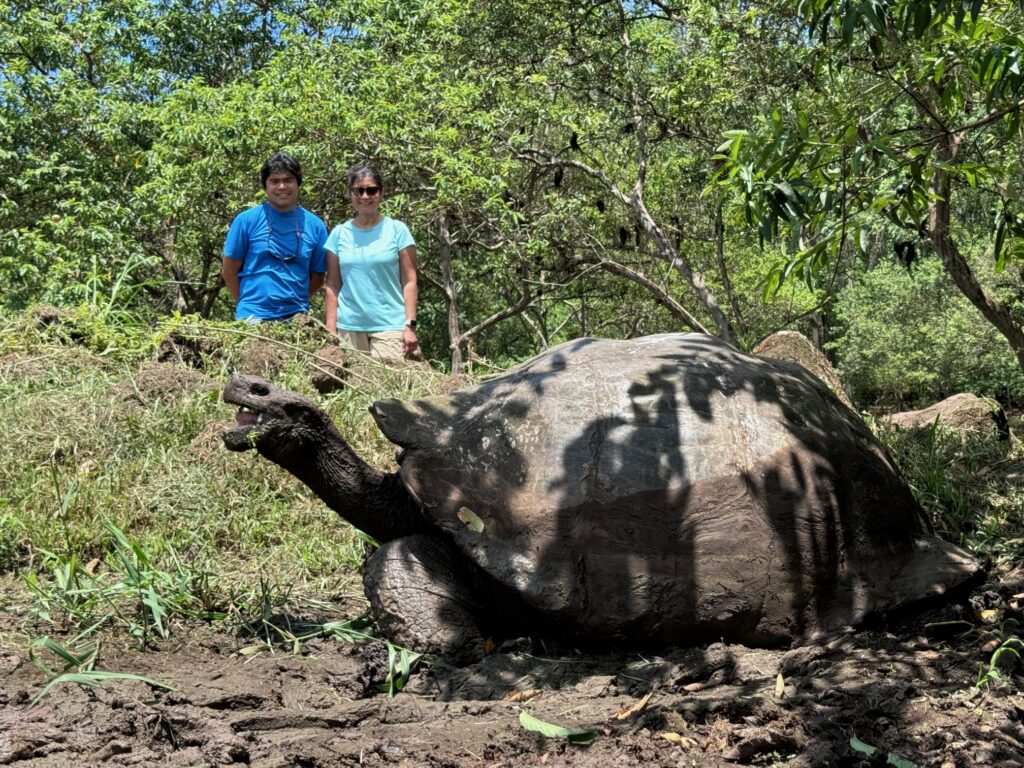One of the many free roaming Galapagos tortoises in Rancho Primicias, Santa Cruz Island
Description
Santa Cruz is the island between Isabela and San Cristobal. Its main town, Puerto Ayora is located at the south end of the island and is the largest settlement among the Galapagos Islands. There are two other settlements but those are located in the highlands (interior) as the inhabitants work on the farms. It takes about an hour and half to reach Puerto Ayora using the public transportation from Seymour airport located on another island to the north.
Puerto Ayora is very walkable unless you are staying at the town’s outskirts.
There are many shops and restaurants along the town’s main street which is Avenida Charles Darwin. You will likely encounter your first wildlife while walking along this street by the shore.
The hub of most activities is at the muelle or port. This is where visitors board water taxis to get on ferry, tour and chartered boats.
What To Do
Los Gemelos
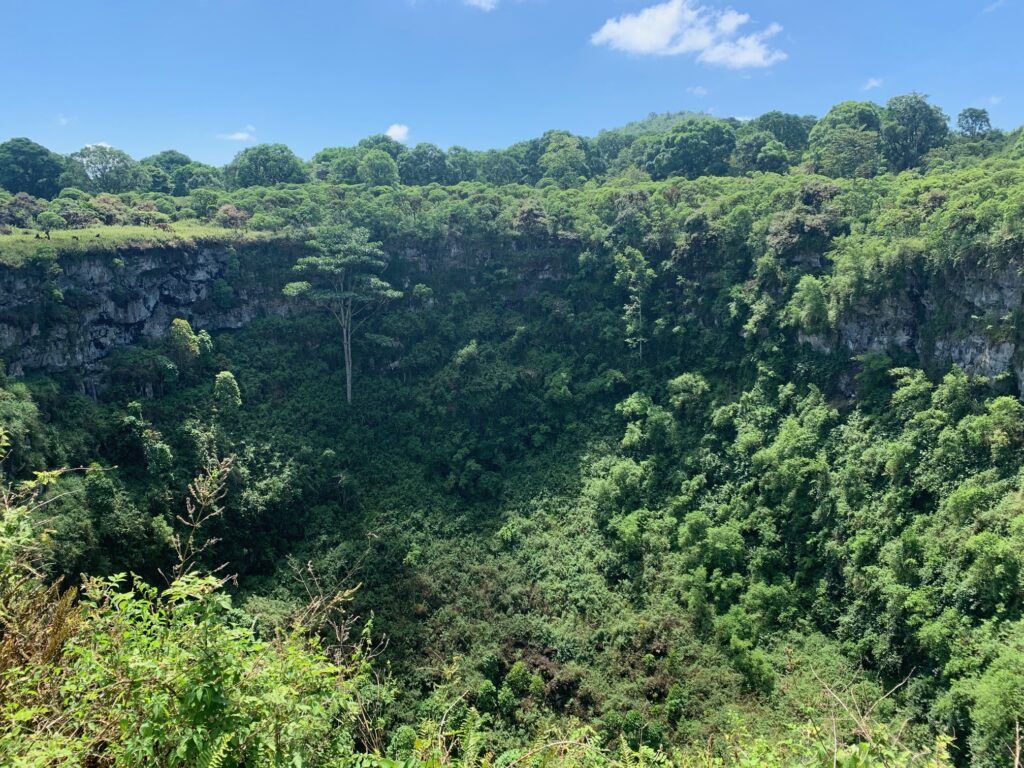

Los Gemelos are two large sinkholes just a stone throw away from the main road between Puerto Ayora and the ferry to the airport. There is about a kilometer walking trail that takes visitors through the mossy covered forest. Endemic birds such as finches can be found here.
Rancho Primicias
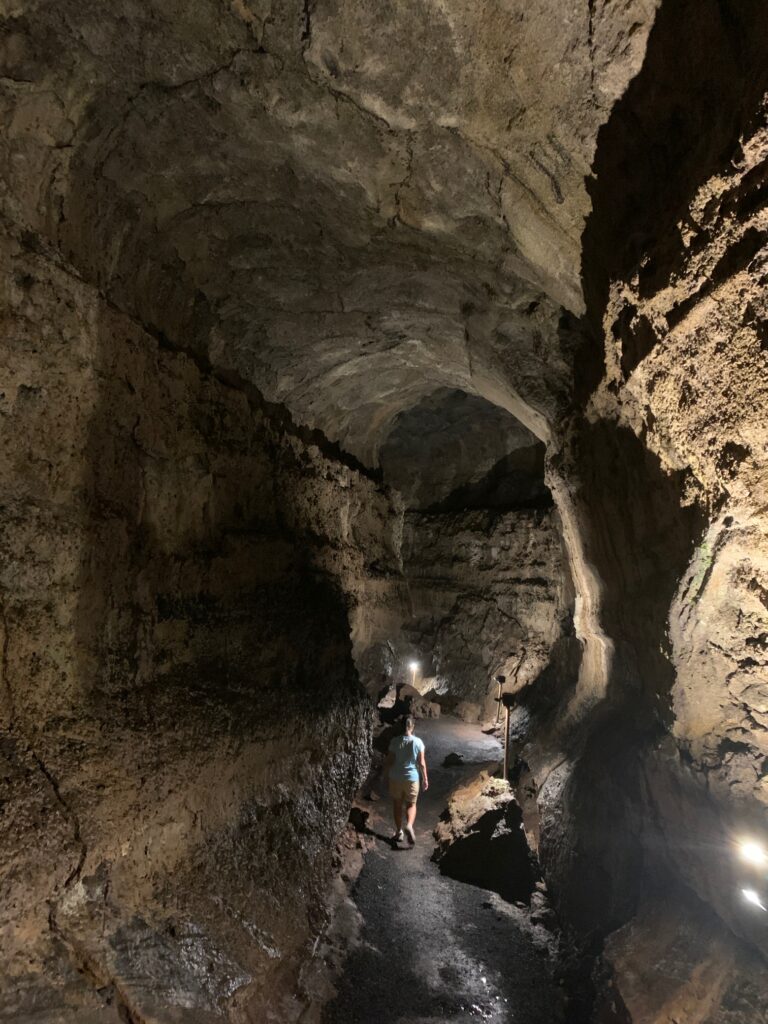

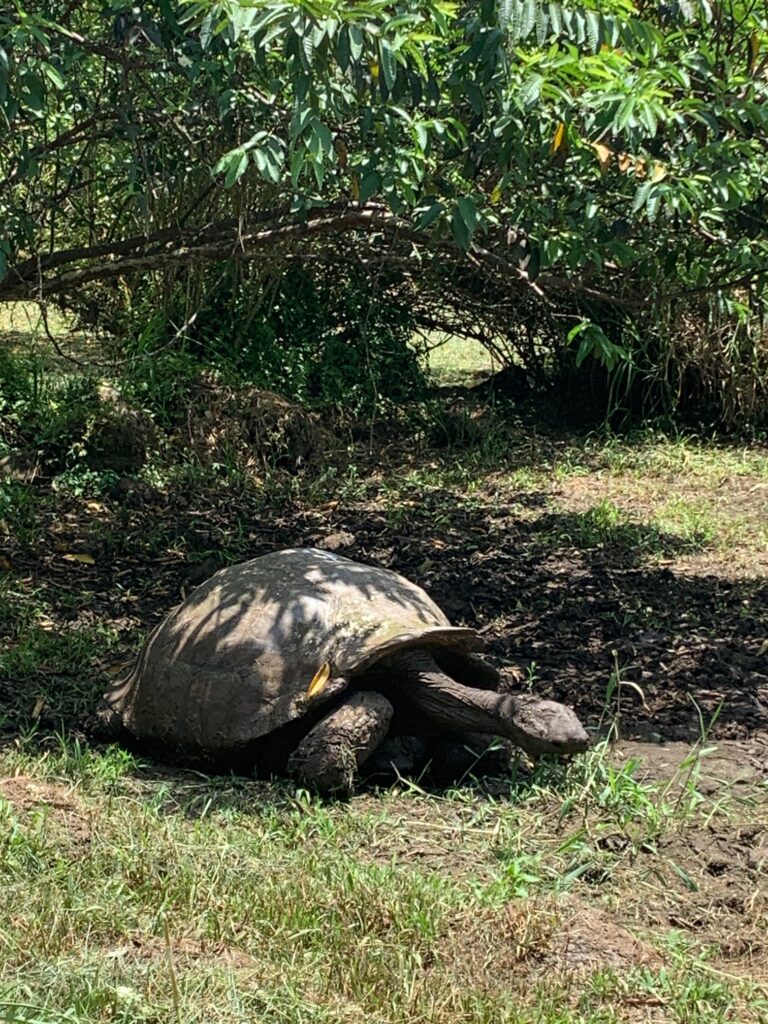

The attractions in this private ranch are the 400 meter long lava tunnel and the freely roaming Galapagos tortoises. The lava tunnel is lighted and is a cool retreat from a hot day. Accessing the lava tunnel is easy as there are access stairs at both ends to get down to it which is approximately 20 feet below the surface. However there is a 10 ft section with low headroom such that we had to squat and slowly inch forward to get through.
Seeing the freely roaming tortoises requires guide accompaniment. The ranch has guides that would accompany visitors that came on their own, i.e. hired a taxi to take them there. The guides are there to make sure visitors stay no closer than six feet away from the giant creatures.
The ranch also has a restaurant where you can have a refreshing drink, meal or both. Entry fee is $5 USD pp. If you use the ranch guides, it is an additional $3.50 USD pp. Payment is cash only.
Garrapatero Beach
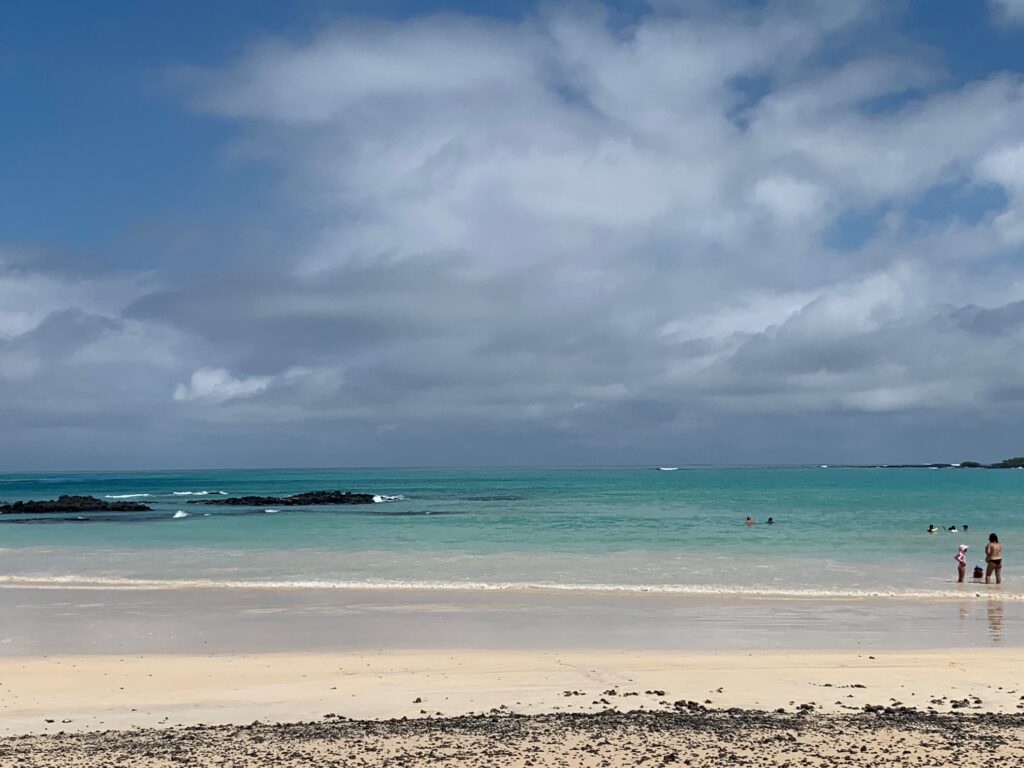

It takes about an hour to drive to the beach parking area from Puerto Ayora. Then it is about a 1 km walk to the beach on a paved path that is on a slight descent (so it is a slight uphill walk on the way back).
Garrapatero Beach has fine beige sandy beach. There are a couple of campsites there too. The beach is about 100 meters long but was not crowded on the day we went. There is only one shade tree by the beach where most visitors hang around if not in the water.
The water’s color is torquoise but not clear. This is not a snorkeling beach although we saw a baby shark and a type of jack in the shallows. For the most part, the water is calm with the occasional foot to two feet high waves.
Tortuga Bay
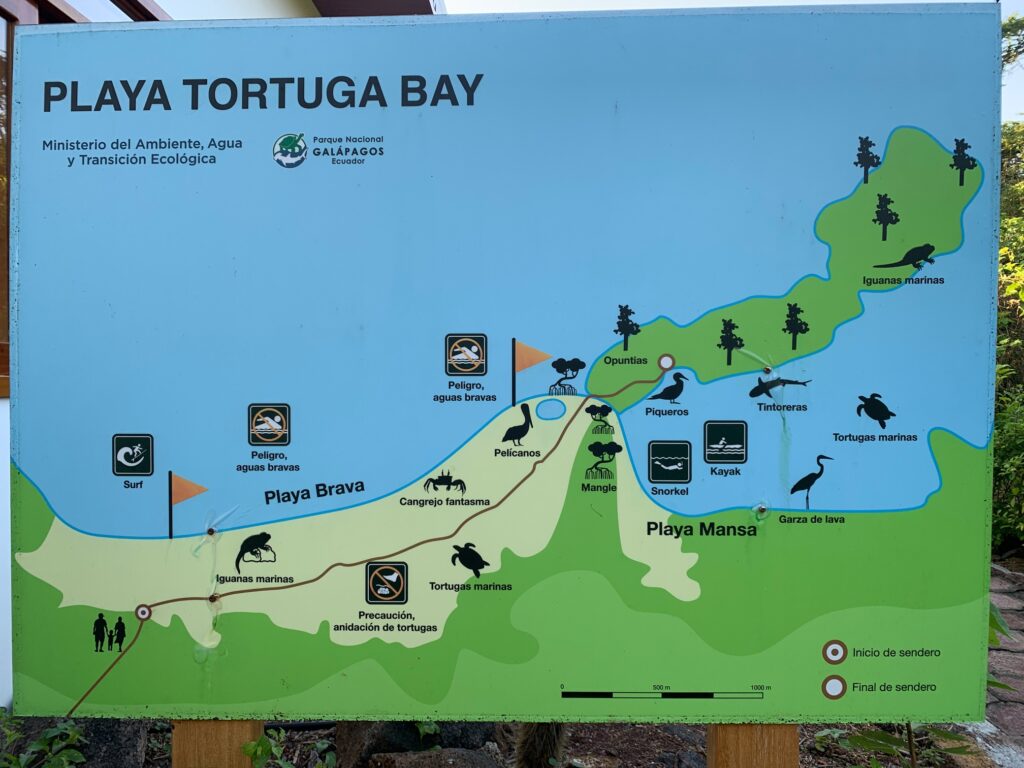

Description
Tortuga Bay is a must do. There are two beaches, Playa Brava and Playa Mansa. No swimming is allowed in Playa Brava due to strong currents and crashing waves. Playa Mansa is the opposite. It is in a large cove bordered by mangroves and volcanic rocks so it somewhat separated from the open ocean.
Playa Mansa’s beach is fine white sand that extends hundreds of feet into the water. The water was calm and did not get above our heads until a couple of hundred feet from shore. Water clarity was between five and ten feet depending on the location. There were also lots of fish, though not colorful as there is no coral. There were even baby black tipped sharks. There are also shade trees on the beach. It is the perfect place to swim.
The bay is within the national park. The park is open from 6AM to 6PM.
Getting to Playa Mansa
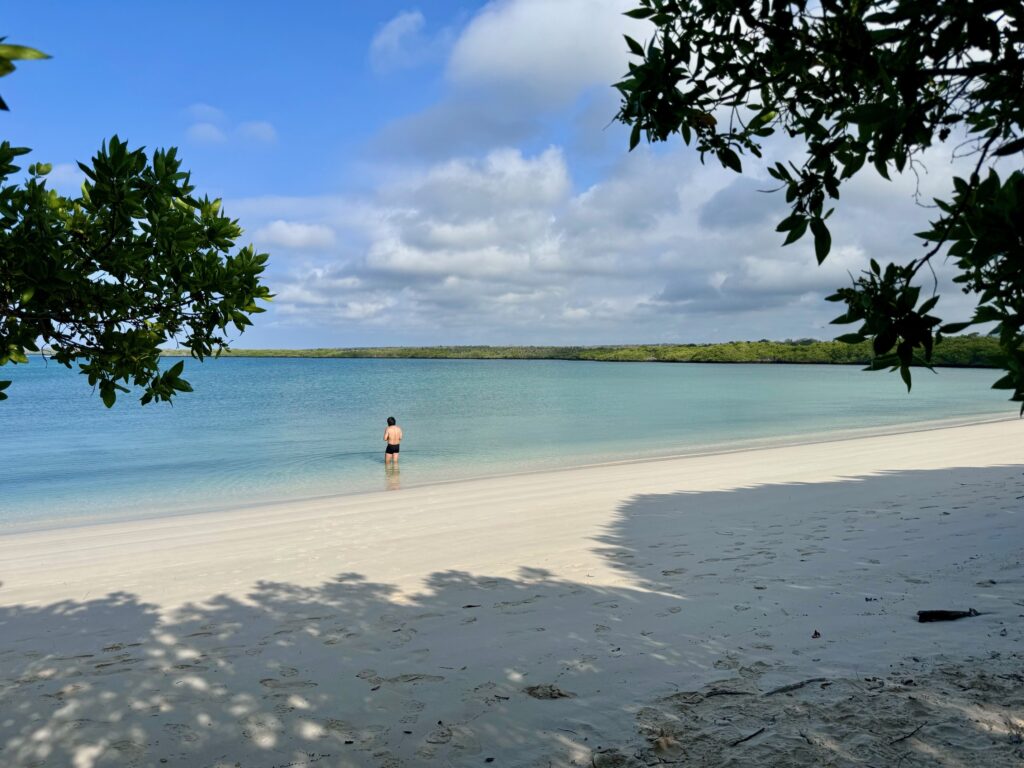

Access to the bay is either by foot or by boat from Puerto Ayora. Playa Mansa is about 1.25 hour walk from Puerto Ayora’s muelle. Stairs need to be climbed to reach the park entrance (about three stories worth). It is a two kilometer paved path between the park entrance and Playa Brava.
It is another kilometer walk along Playa Brava to reach Playa Mansa. Playa Brava’s sand is somewhat firm so it is not difficult to walk on. By mid-morning (around 9 AM) it was hot to walk on this beach because there is no shade. Best to bring an umbrella to cut down the sun’s searing rays.
There is a shuttle boat that goes to Playa Mansa from Puerto Ayora. There are three departure times as well are return times (see picture) below.
Getting Back to Puerto Ayora
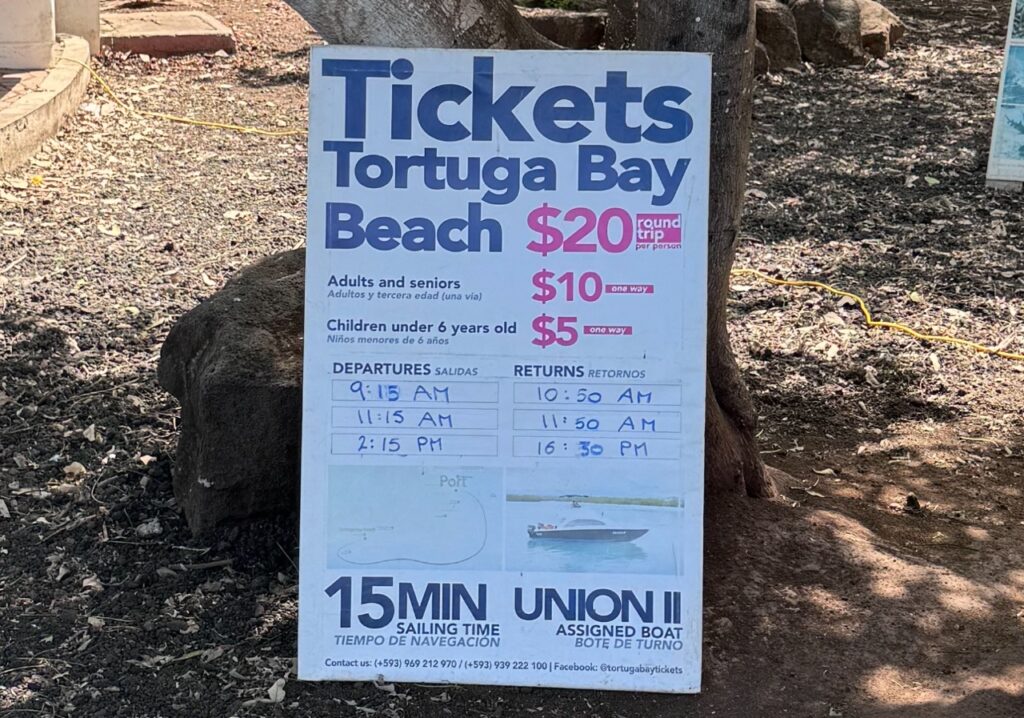

You can either walk back to Puerto Ayora or take a boat back. It is the same way out as the same way in when walking back.
Some people walk to Playa Mansa and take the shuttle boat back to Puerto Ayora. It costs $10 USD pp (cash) for the boat ride. At around 10 AM, there will be a person holding a pen and paper at the near end (closer to Playa Brava) of the beach asking people if they need a ride. If there are a lot of people, the person may not even ask as he or she will be swarmed with people vying for a boat seat. The boat’s capacity is around 20 and gets filled quickly when there are many people on the beach.
Best Time To Go
As soon as the park opens (6AM) is best for three reasons. First is to avoid the heat during the walk in (the earliest public boat leaves Puerta Ayora at 9:15 AM). Second is Tortuga Bay would be empty of beachgoers. There maybe locals doing their morning walk at Playa Brava but that is about it.
Third reason is you will have a better chance of seeing wildlife. We arrived at 8AM at Playa Mansa and saw a white pelican, lots of marine iguanas, a heron and a pair of blue footed boobies. They were all gone from the places we saw them two hours later.
The crowd started arriving at 9AM and the tranquility of the place abruptly changed to restaurant style atmosphere where we heard people from all sides talking. This was at the beache’s near end. It was not as bad at the far end though there was no benches to sit on.
Las Grietas and Playa Alemana
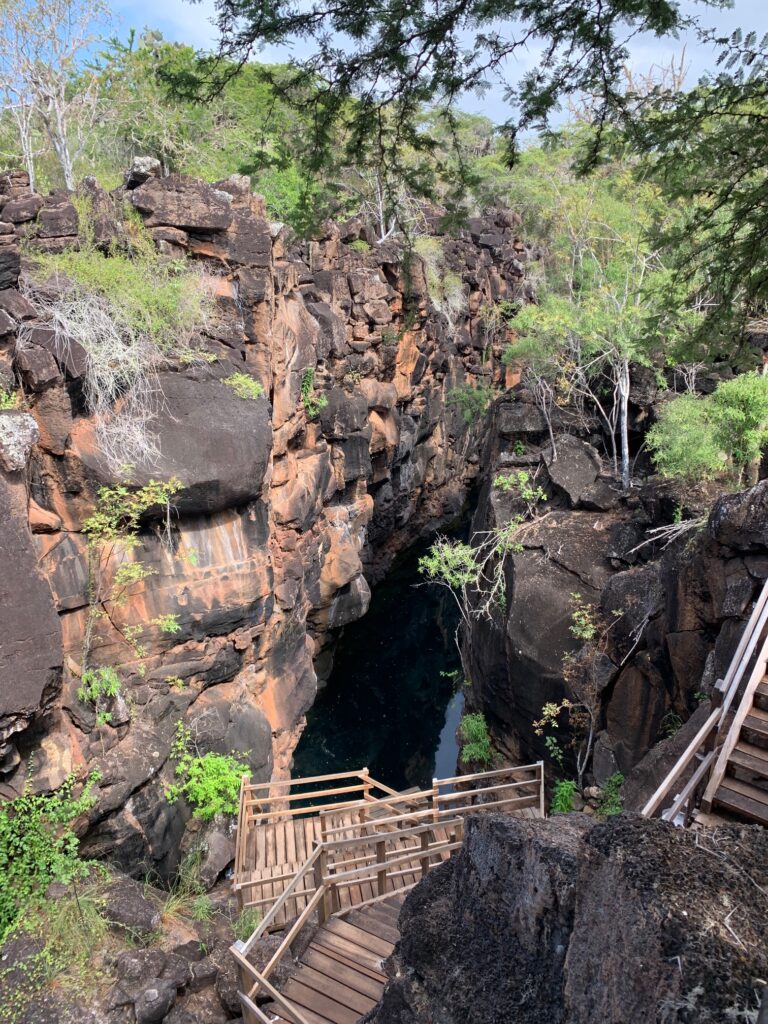

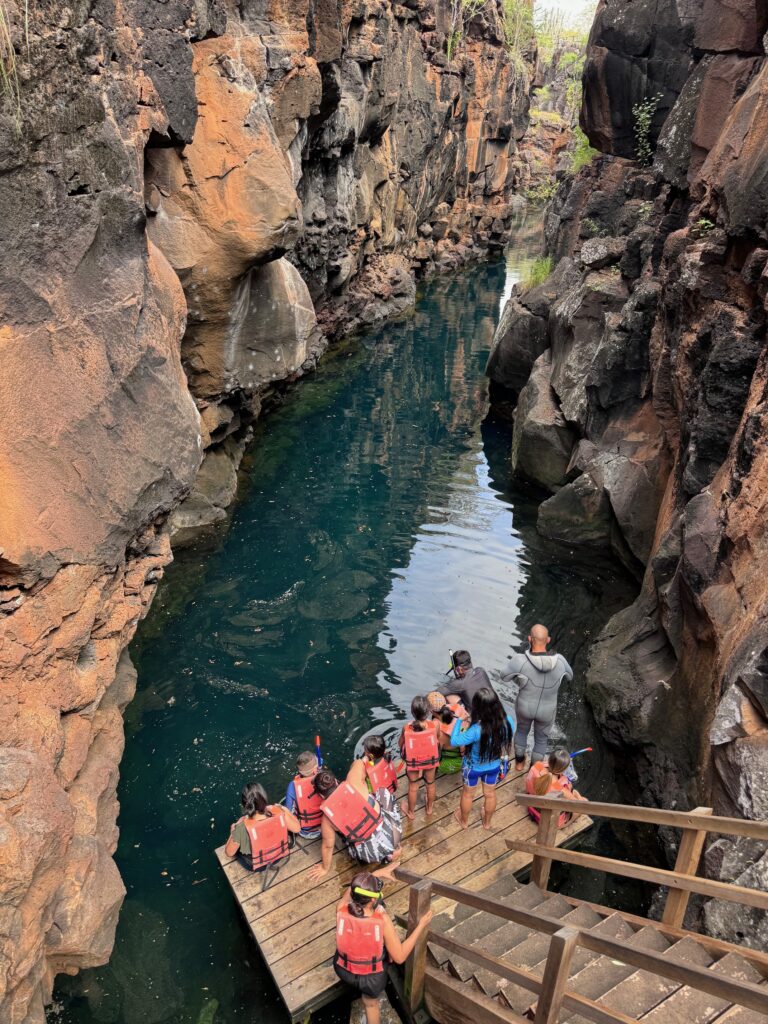

Las Grietas is a narrow canyon between 20 and 30 feet wide. The walls are volcanic rocks that goes straight up perhaps 30 to 40 feet high in some places.
Las Grieta’s draw besides being a canyon is it is a popular swimming hole. The canyon has filtered sea water that is cool and refreshing. The water is shaded by the canyon wall except when the sun is directly above it. Each end of the canyon has stairs that lead down to the water. The access stairs are designated #1 (West end) and #2 (East end).
Las Grietas is within the national park and visitors need to be accompanied by a guide. There are guides at the park entrance and the cost was $10 pp. By coincidence, we rode with a tour group in a water taxi on our way to Las Grietas. We just paid the group’s guide directly instead of hiring one of the guides at the entrance.
There are time slots to swim in Las Grietas. Visitors are generally allowed one hour to enjoy the cool refreshing water before the next set of visitors arrive. This prevents overcrowding and makes the place more enjoyable. The guide also makes sure that anybody that is supposed to leave, leaves when their time is up.
The drawback of hiring a guide at the park entrance is that you may have to wait for an open time slot. Normally, tours groups have reserved a time slot and can proceed directly to the swimming hole on arrival. Visitors are directed by park employees to whichever swimming hole, #1 or #2, is available. Visitors cannot pick and choose a swimming hole.
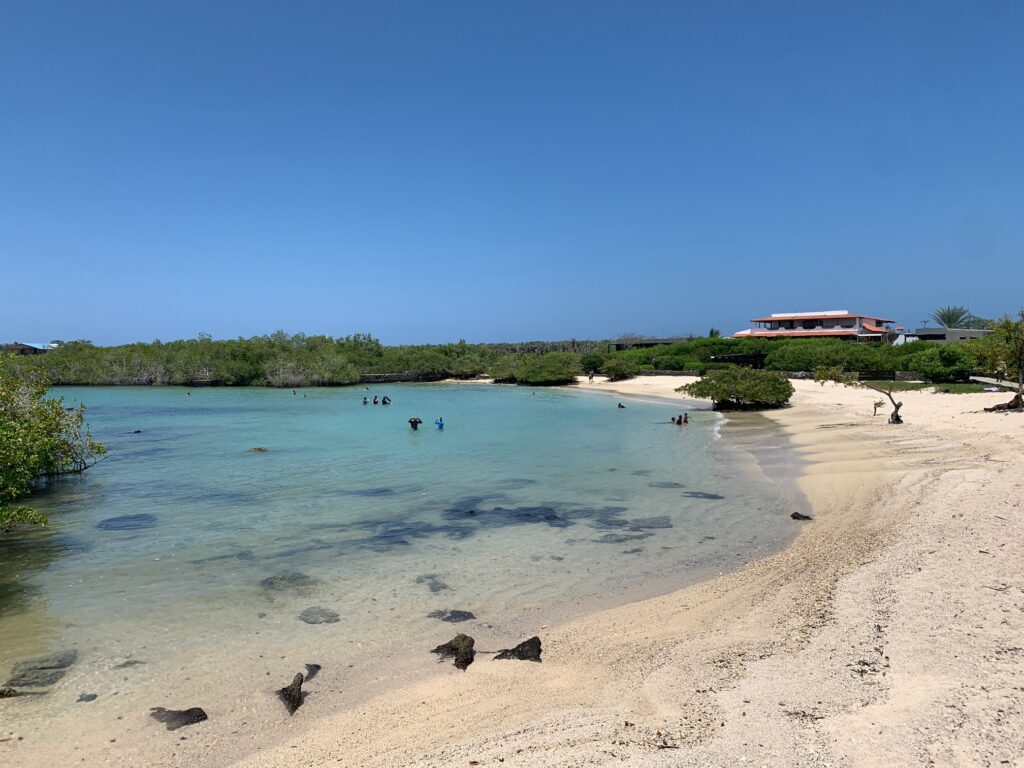

Playa Alemana is a short beach with not a whole lot of shade trees. You will pass by Playa Alemana on the way to Las Grietas. A guide is not needed nor is there a fee to swim in It.
Tours
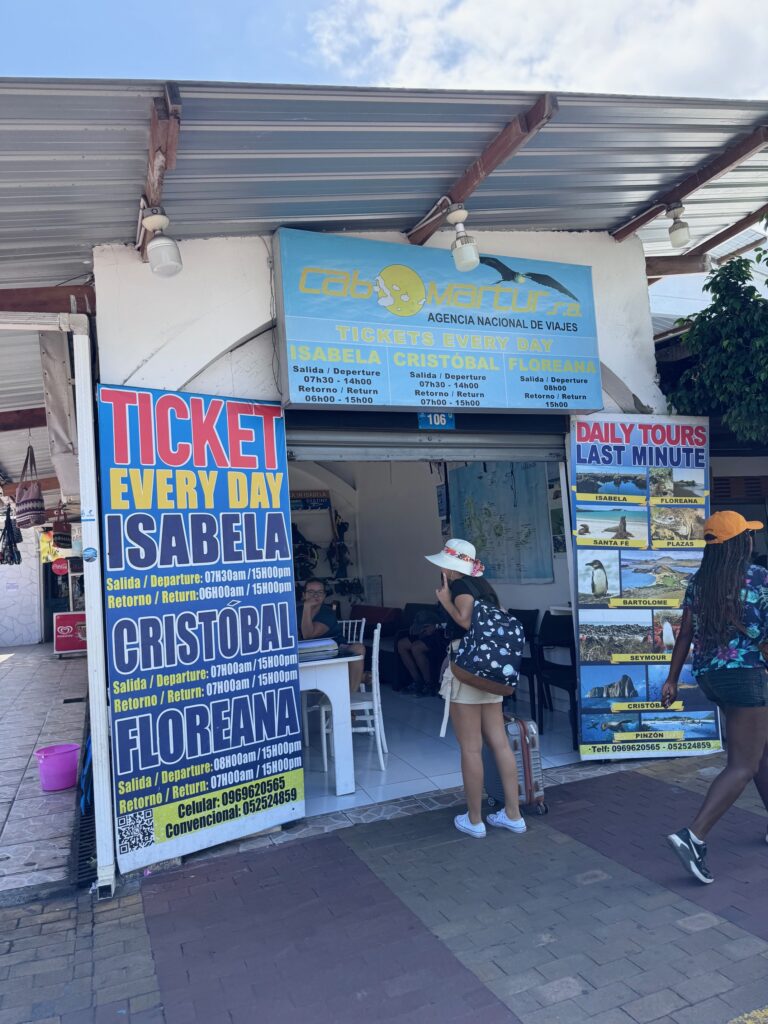

You will find the majority of tour companies along Avenida Baltra beginning at the intersection with Avenida Charles Darwin. They line both sides of the streets for at least a couple of blocks.
We knew that Galapagos liveaboard cruises are expensive based on what we researched on-line. We walked into one of the tour companies that have a “Last Minute Cruise” sign and they told us that they had an eight day cruise for $2,500 USD per person. We did not ask for the details as we were not going to do it. Seems eight days of snorkeling was just too much for us.
Getting Around
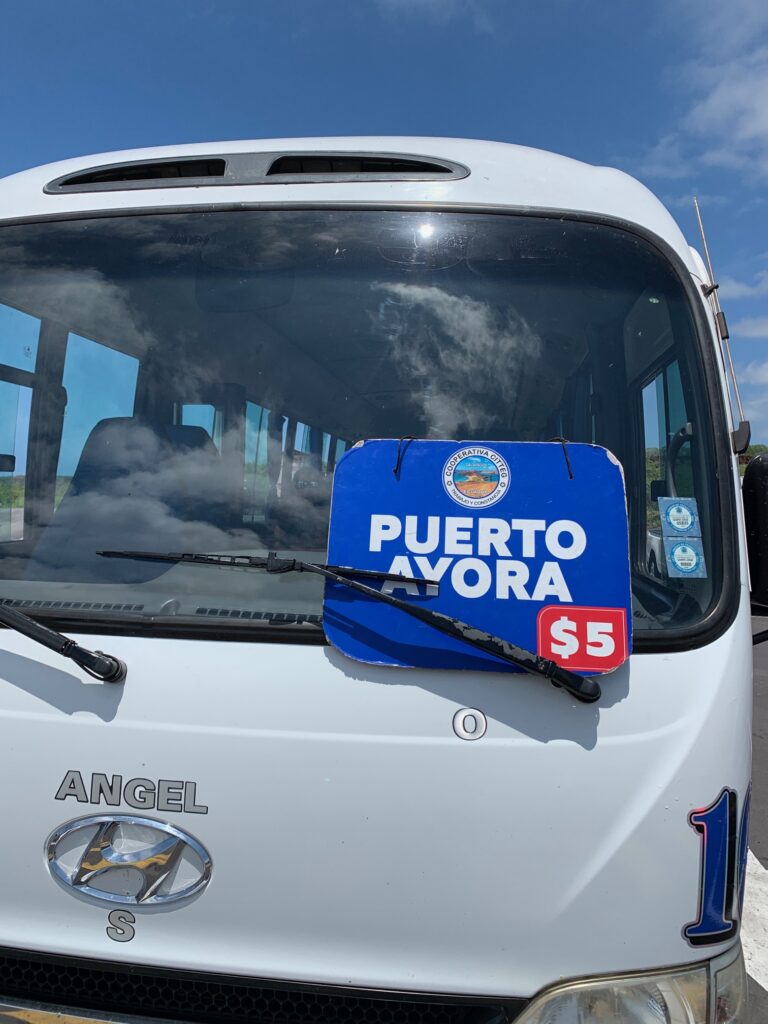

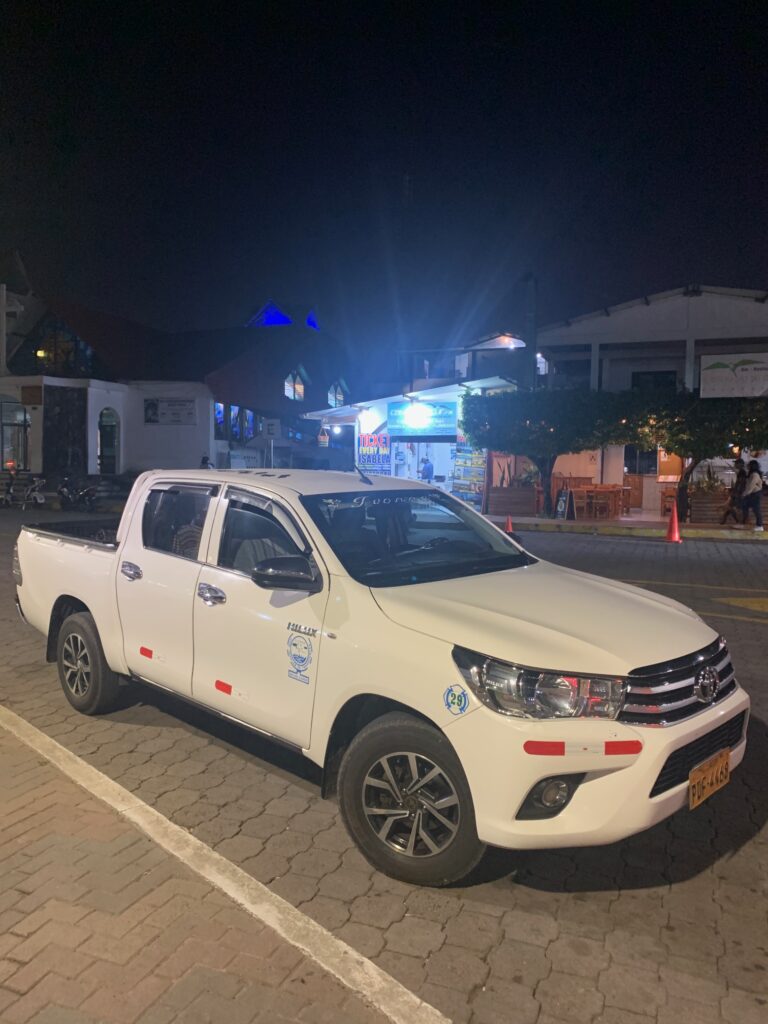

There are four means of transportation in Santa Cruz. These are buses, taxis, tours and bicycles.
Buses
There are two types of buses, blue buses and those that belong to the Cooperativa de Transporte (CITTEG).
The blue buses go between other villages and Puerto Ayora. They are stationed in the city center along Ave Baltra. CITTEG buses go between Puerto Ayora and the ferry station at the north end of the island. This is what you would take to go to the airport. You can catch the CITTEG bus at the Terminal Terreste de Puerto Ayora on Avenida Padre Julio Herrera. This bus ride costs $5 USD.
If you are flying into Seymour Aiport in Baltra Island (code: GPS), there is a $5 bus that shuttles visitors from the airport to the canal. Then it is a $1 ferry boat ride to cross the canal so visitors can hop on the CITTEG bus to Puerto Ayora.
Taxis
There are taxis in Puerto Ayora. These are dual cab white pick-up trucks that has a transportation logo painted on the body. Some would say Com Insular de Transportes, Cooperativa Transito (CTC) or others. The cost was $1.50 per ride within Puerto Ayora. You would take a cab to take you to the CITTEG bus station if it is too far from your accommodation.
You can privately hire these taxis to go around the island. The cost is dependent on where you intend to go and for how long. A fellow traveler told us that they hired one for $60 for the day (9 AM to 4 PM). Even though taxi drivers are local, they cannot act as your tourist guide. Their responsibility is to take you to the place and that is it. They will wait for you in the vehicle until you are done with whatever you want to see and do at a particular location. They are not allowed to accompany you while you are exploring. This ensures they do not compete with licensed guides.
Guided Tours
Guided tours normally include transportation and a guide accompaniment. There are several tours to choose from.
Guides undergo six months of schooling and must pass an exam to be licensed. They also wear either a white or khaki top uniform when guiding.
Bicycles
A fourth way of getting around is renting a bicycle. But the seasons in Galapagos is hot and hotter so it may not be for everyone. Plus Santa Cruz is a sizeable island.
How Many Days
Like the other islands, it all depends on what you want to do. We spent three nights in Santa Cruz and were satisfied of what we did and saw without having to go on an expensive tour around the island or to other islands.
A sample itinerary could be Tortuga Bay one day, visiting the highlands (Los Gemelos and Rancho Primicias) another day. Garapaterro Beach, in our opinion is not worth it, especially if you are going to Tortuga Bay.
We did Las Grietas while waiting to take the afternoon ferry boat to San Cristobal. We just left our luggage at the ferry office.
Where to Eat
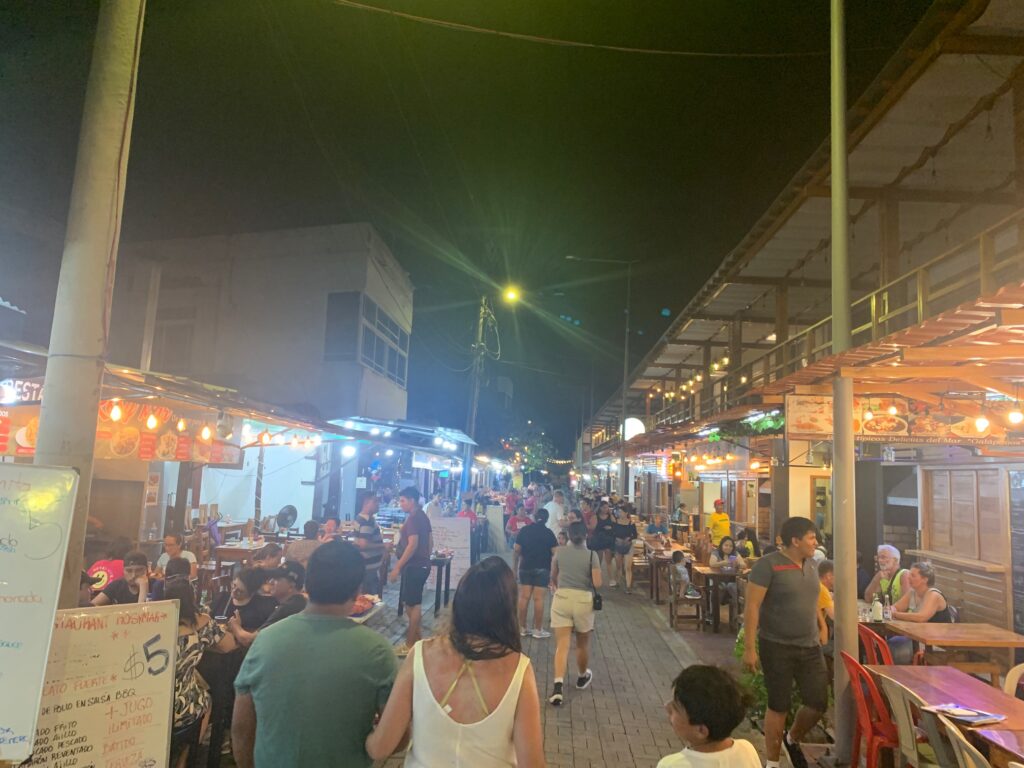

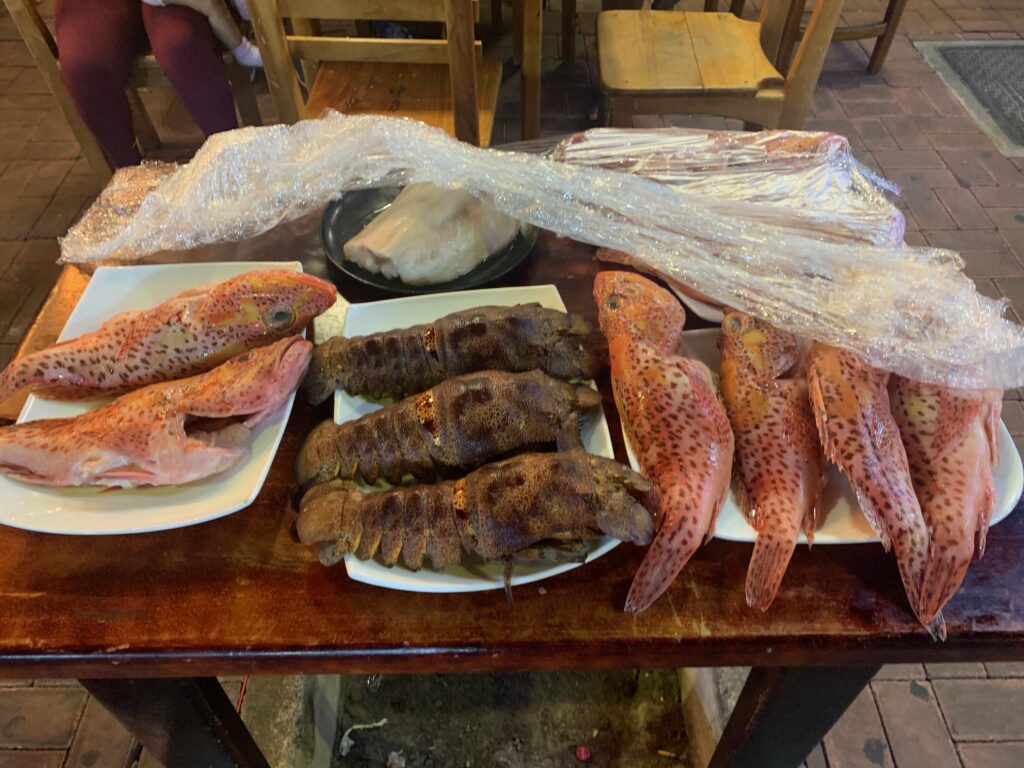

Most of the commercial establishments like shops and restaurants are located along Avenida Charles Darwin. Just head down towards the shore and you will hit this bustling street. There are no shortage of places to eat and it can be overwhelming.
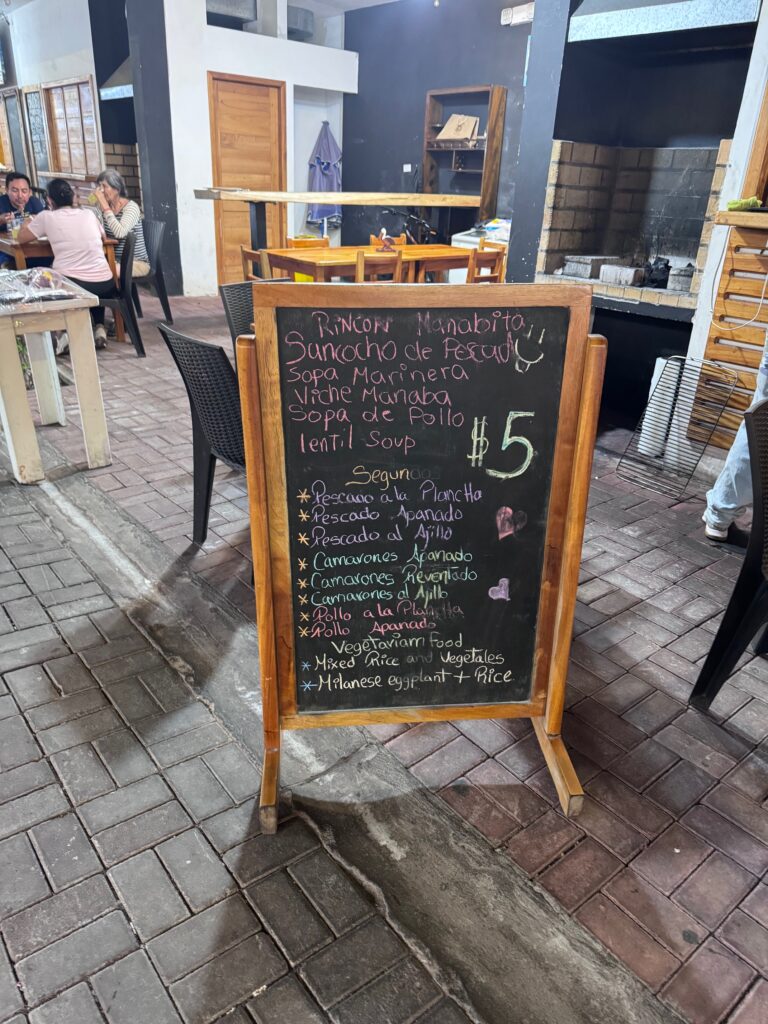

But if you are on a tight budget, head on over to the intersection of Avenida Baltra and Charles Binford Street. There are several restaurants on both sides of Binford that will tempt your tastebuds. All of them have fresh scorpion fish, large langoustine and other ocean fish on display. Cost depends on the size but are reasonable compared to the fancier restaurants along Avenida Charles Darwin. Most of them have $5 USD meals that include soup, a main dish and drink.
ATMs and Credit Cards
We saw two ATMs while walking in Puerto Ayora, Santa Cruz. There was a couple at Banco del Pacfico located near the intersection of Isla Floreana and Avenida Charles Darwin. Charles Darwin is the street by the ocean. There was also an ATM beside the Proinsular Market by the boat ferry dock.
Credit cards are widely used by restaurants and shops along Avenida Charles Darwin. Cash is main payment when you venture away from Avenida Charles Darwin

